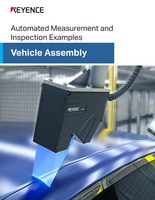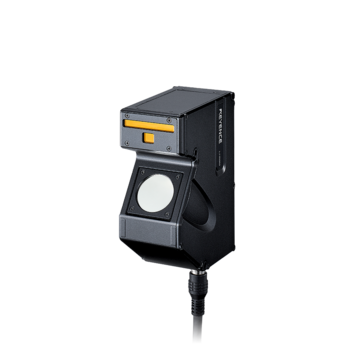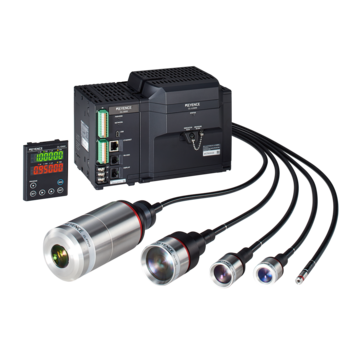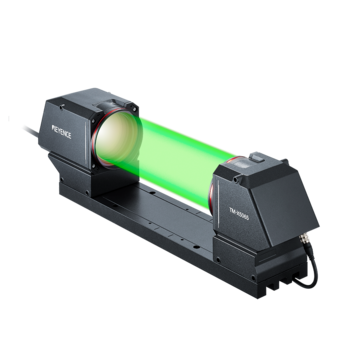Measurement Sensors
- 2D/3D Laser Profiler LJ-X8000 series
- High-speed 2D Laser Profiler LJ-V7000 series
- 2D Laser Displacement Sensor LJ-G5000 series
- Confocal Displacement Sensor CL-3000 series
- Ultra High-Speed/High-Accuracy Laser Displacement Sensor LK-G5000 series
- High-Speed, High-Accuracy CCD Laser Displacement Sensor LK-G3000 series
- Image-Based Laser Sensor IX series
- CMOS Multi-Function Analog Laser Sensor IL series
- Telecentric Measurement System TM-X5000 series
- High-speed optical micrometer LS-9000 series
- High-speed 2D Optical Micrometer TM-3000 series
- High-speed, High-accuracy Digital Micrometer LS-7000 series
- Multi-Purpose CCD Laser Micrometer IG series
- Thrubeam Type Laser Detection Sensor IB series
- 3D Interference Measurement Sensor WI-5000 series
- Micro-head Spectral-interference Laser Displacement Meter SI-F series
- Spectral-Interference Wafer Thickness Meter SI-F80R series
- High-speed, High-Accuracy Digital Displacement Inductive Sensor EX-V series
- Inductive Gauging Sensor AS series
- High-accuracy Positioning Sensor EG series
- High-Accuracy Digital Contact Sensor GT2 series
- General Purpose Digital Contact Sensor GT series
Dimension Measurement
Displacement Measurement
- Measurement Sensors for the Medical and Pharmaceutical Industry
- Measurement Sensors for the Fiber Optic/Cable Industry
- Measurement Sensors for the Film and Sheet Industry
- Measurement Sensors for the Electric Vehicle Industry
- Measurement Sensors for the Semiconductor Industry
- Measurement Sensors for the Electronics Systems Industry
- Measurement Sensors for the Food and Beverage Industry
- Measurement Sensors for the Automotive Manufacturing Industry
- Measurement Sensors for the Metal and Steel Industry
Measurement Sensors for the Electronics Systems Industry
The demand for better, faster, and smaller electronics continues to rise as customers become more reliant on connected devices. KEYENCE sensors provide solutions for inline inspection and measurement that are accurate and fast enough to keep pace with the ever-evolving electronics industry. Below, we take a closer look at some of these applications and how KEYENCE's measurement sensors can contribute to the success of the electronic production process.
Importance of Precision Measurements in the Consumer Electronics Industry
The electronics industry’s massive development since the invention of the transistor shrunk many components in size while increasing their effectiveness. This gave birth to several new branches with the word “micro” in their name, including micro components in various electronic systems.
These components are incredibly small (some smaller than a poppy seed), and in the electronics industry, they’re mostly handled and inspected by robots. These robots rely on numerous sensors to ensure every component is in the right spot. Such components are usually placed onto boards by pick-and-place robots that arrange and align them onto pads at fantastic speeds, often multiple at a time.
After placing components, machines use precision measurement sensors to check for possible misalignments. This takes place before the components go to soldering and ensures that everything is positioned correctly.
Correct position and orientation of components and defective component detection are crucial, as they ensure the quality of the electronic system and increase the effectiveness of the entire process by eliminating human operators, who are more prone to error.
Electronic Component Inspection
Bigger components, such as ICs and various chips with SON and TSOP footprints, might get misaligned during pickup and placement. In order to avoid product failure due to misalignment, the electronics industry frequently relies on 2D laser profilers such as the LJ-X8000 Series to detect misalignment and trigger a warning or other appropriate automated action.
Electronic Component Assembly Inspection
Once the components are positioned and checked for alignment, they are transferred to the reflow oven, where the solder is melted. This crucial step requires that all components on the electronic system board are precisely aligned.
After the solder finishes melting, component alignment and the quality of the solder joints are checked using 2D laser profilers once again. Their single-digit µm accuracy allows them to detect misaligned components or cracks in solder joints, which are most likely to expand and lose connection once the electronic system heats up during operation.
This type of inspection typically relies on sensors like the aforementioned LJ-X8000 Series laser profiler paired with a data logger. This allows for accurate measurement and data storage, resulting in more effective quality control.
Types of Measurement Sensors for the Consumer Electronics Industry
As previously explained, the electronics industry relies on several different measurement sensors. Measurement sensors are used to inspect component placement and solder quality, with defect detection at an enviable µm scale. Laser displacement sensors are particularly useful in automated assemblies as they also ensure precise component placement.
Integrating Measurement Sensors into Consumer Electronics Inspection Processes
If you want to learn more about precision measurement in electronics or how to increase the effectiveness of your manufacturing process while simultaneously cutting down on various costs associated with revisions and downtime, ask KEYENCE. Our trained and professional staff will respond to any inquiries you might have.
Related Downloads
Related Products
Applications
Dimension Measurement
Displacement Measurement
Profile Measurement
Industries
- Measurement Sensors for the Medical and Pharmaceutical Industry
- Measurement Sensors for the Fiber Optic/Cable Industry
- Measurement Sensors for the Film and Sheet Industry
- Measurement Sensors for the Electric Vehicle Industry
- Measurement Sensors for the Semiconductor Industry
- Measurement Sensors for the Electronics Systems Industry
- Measurement Sensors for the Food and Beverage Industry
- Measurement Sensors for the Automotive Manufacturing Industry
- Measurement Sensors for the Metal and Steel Industry




